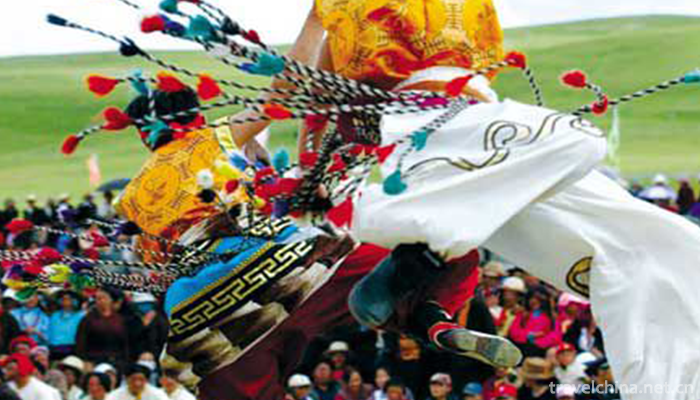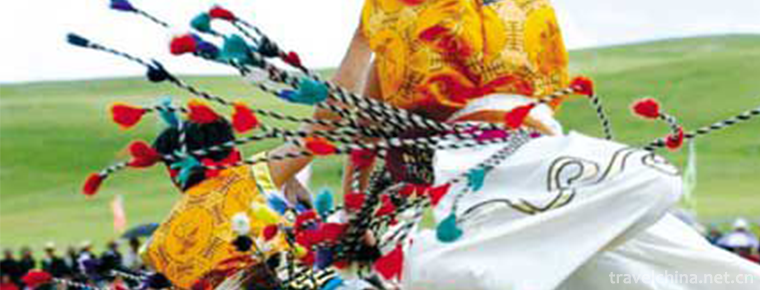Reba Dance
Reba Dance
Reba dance is a form of dance performed by Tibetan "Reba" artists. Reba is a group of street artists who make a living selling arts (usually composed of family as the basic unit) performing, mainly with bells and drums, integrating rap and singing, harmony (singing and dancing), acrobatics, Qigong and Reba opera. It has a relatively fixed set of procedures, consisting of 12 programs, and a full set of performances takes five hours.
On May 20, 2006, Reba Dance was approved by the State Council to be included in the first batch of national intangible cultural heritage list.
historical origin
According to historical records, the production of Reba Dance was founded in the 11th century AD by Milarepa, the second generation ancestor of the Gaju School of Tibetan Buddhism. Others believe that the Reba dance was handed down by Buddhist Dang Bassanger. "Eight Qings of Karma" is the mantra that Aragogue, Master of Bassanger, recites when he sees the devil destroying the people, that is, when Aragogue, a Buddhist monk of Karma sect, sees or hears someone suffering.
There are many legends about the origin of Reba. Legend has it that people built a nine-storey temple at the confluence of the three rivers of Soza, Merry and Shenggua. The rulers tempted people to build temples for them. Five men and five women, one of the founders of Karma, performed drums in their spare time and held a dance festival every floor. After several years of construction, the temple has been built, the drums of Reba have increased, and the dance has also enriched.
Reba Dance Ding Qing Reba
It is believed that the founder of Reba Dance was Milarepa (1040-1125 AD), a Buddhist practitioner who wrote the Taoist Song of Milarepa. Milarepa was born in a place called "Qiongxie", and Ding Qing has been known as "Qiongpu Ding Qing" since ancient times. People in the area generally believe that Milarepa was born in Ding Qing, and Ding Qing has the reputation of "Home of Reba". It is said that Milarepa killed an elephant when he was young. The elephant's skin was laid on the ground, and Miraziba danced on it to worship the gods, thus creating the Reba dance. Up to now, the props and decorations used in the performance of Reba dance also come from the legend of the sacrifice of the god, Milarepa takes the big rib of the elephant as the drum frame, takes the thin skin under the stomach as the drum skin, uses the small rib as the drum mallet, and uses the like intestine as the mesh skirt ear. This legend not only smeared a magical color for folk Reba dance, but also made a direct footnote for the development of dance art from primitive altar to folk.
It should be said that the origin of Reba dance is much older than that of Milarepa. Its predecessor was the ancient local religion before Buddhism was introduced into Tibet, namely the witch dance or totem dance of Ben religion. Ding Qing is an important place for the spread of Ben religion. Zizhu Temple, 40 kilometers away from Dingqing County, is the largest and most complete benzo monastery in Tibet. Experts generally believe that the symbol of the rise of Ben religion from Ali, Tibet, to spread outward is the Zizhu Temple in the area of "Qiongpu Dingqing", and then Ben religion is spread to the area of Linzhi Ben Rishen Mountain. Therefore, the ancient Ben Shamanism witch dance experienced several historical years of precipitation in Ding Qing spread to the folk, become Ding Qing Reba dance has sufficient conditions and reasons.
Hoba Dance. That song, such as Dingar Hoba
According to local artists'recollections, such as the Tibetan version of Naxu Zhiru History written by Renwang Danzeng and Solandoji, the CPPCC, the earliest Dinggar Reba was an independent dance art created and developed on the basis of the original folk Reba by Milarepa and Reqingba, the second generation ancestors of Tibetan Buddhist Kaju School in 1040 A.D. This kind of Reba dance has experienced the development and evolution from the folk to the temple and from the temple to the folk in history.
The Dingga people belonged to the Naxiu tribe in northern Tibet since ancient times, while the Naxiu tribe is famous for its ability to sing and dance. People express their feelings in the form of singing and dancing. Over time, Dingga people have their own songs and dances. In the long evolution of the years, they constantly absorbed and integrated foreign art, and finally formed a unique form of singing and dancing for the Dingga people - Dingga Reba.
Current situation of inheritance
"Reba" used to be a skill and difficult dance for professional folk artists to survive by selling art. The formation of Reba Team usually takes the family as the core, or several families cooperate to form a team, with more than 20 people and less than 4 or 5 people, all of whom are capable of singing and dancing and have their own unique skills. There are strings (Erhu), drums, bells and other instruments accompanied. The whole performance was complete and rigorous, with rich drama and sports contents and implications. It is a kind of national folk sports dance with a very good fitness function. "Reba" is popular in Changdu and Gongbu areas in eastern Tibet and in Yushu Tibetan areas in Yunnan, Sichuan and Qinghai provinces.
Inheritance Significance
Reba's predecessors were "witchcraft" and "totem dance" of the Tibetan primitive religion "Ben" religion. It has a long history, rich content, unique style, superb skills, funny Taoism and peculiar mask. It also absorbs the essence of ancient Xiangxiong culture, religious culture and folk art, thus becoming a wonderful flower in the splendid ancient Tibetan culture and art. It has high artistic value and research value. Reba dance is distributed in Changdu, Gongbu, Naqu and other Tibetan areas such as Yunnan, Sichuan, Qinghai and Gansu.
Reba Dance Ding Qing Reba
Dingqing Reba is an indispensable unique variety of Tibetan folk dance, with its ancient tradition, numerous schools and superb skills. After liberation, although there was a decreasing trend in the number of folk Reba artists, they not only inherited the traditional Reba better, but also made some reforms in acting skills and costumes to meet the needs of stage performances because the literary and artistic workers at all levels went deep into their lives and worshiped the folk artists as teachers. Nowadays, the Reba dance has been on the stage at home and abroad, and is loved by the audience. In 2002, Dingqing County was named "Hometown of Reba Art" by the people's government of Tibet Autonomous Region. In today's fragrant world of so-called flooding of modern art, the reason why Ding Qing Reba can last forever and become a history of dancing and singing is that it can spread for hundreds of years, and successors have benefited from the efforts of those folk artists who love and devote themselves to the art of Reba. It is their efforts that have made this ancient cultural and artistic form, which is loved and welcomed by people, passed down from generation to generation and become more perfect.
Dingqing Reba, as an ancient and splendid national culture and art, is obliged to develop and inherit it by relevant organizations and individuals at all levels under the protection of national policies.
Hoba Dance. That song, such as Dingar Hoba
For hundreds of years, Dinggar Reba has been improving with the joint efforts of Dingga villagers, and its dance styles and programs have become more and more abundant. Dingga Reba contains the traditional Tibetan culture, reflects the creative ability of Tibetan people's excellent singing and dancing art, reflects the open integration of Tibetan culture, and is unique in Tibetan Reba dance.
The state attaches great importance to the protection of intangible cultural heritage. On May 20, 2006, it was approved by the State Council and listed in the first batch of national intangible cultural heritage lists. On June 8, 2007, the Jumbureba Dance Performance Team of Dingqing County, Changdu District, Tibet Autonomous Region won the first Cultural Heritage Day Award promulgated by the Ministry of Culture.


-
1.Jiuzhaigou Valley Scenic and Historic Interest Area
Jiuzhaigou: World Natural Heritage, National Key Scenic Spots, National AAAAA Class Tourist Scenic Spots, National Nature Reserves, National Geoparks, World Biosphere Reserve Network, is the first nat
Time 2018-10-13 -
2.Donkey HamBurger
Donkey HamBurger is a popular traditional snack in North China. It originated in Baoding. Widely spread in the central Hebei Plain, the brine good donkey meat adds the old soup to join the crispy fire
Time 2018-11-07 -
3.Bassoon ba song cuo
Basongtao, also known as Caogao Lake, means "green water" in Tibetan. It is about 18 kilometers long. Its surface area is about 27 square kilometers.
Time 2019-01-02 -
4.Jin Memorial Temple
Jinci Temple is located in Jinci Town, Jinyuan District, Taiyuan City, Shanxi Province. It was originally called Jinwang Temple and was first named Tang Shuyu Temple.
Time 2019-01-29 -
5.suyukou national forest park
Suyukou National Forest Park is located in Helan Mountain National Nature Reserve, 50 kilometers northwest of Yinchuan City, capital of Ningxia. It is a national 4A-level tourist attraction.
Time 2019-02-13 -
6.Yishui Underground Fluorescent Lake Scenic Area
Yishui underground fluorescent Lake tourist area is now renamed as the fluorescent insect water tunnel tourist area.
Time 2019-03-03 -
7.Sintering Techniques of Chengcheng Yaotou Ceramics
Yaotou Ceramic Firing Skill in Chengcheng, a traditional handicraft in Yaotou Town, Chengcheng County, east of Guanzhong, Shaanxi Province, is one of the national intangible cultural heritages.
Time 2019-04-18 -
8.Huaihai Opera
Huaihai Opera, one of the national intangible cultural heritage, is a local traditional drama in Huaian City and Lianyungang City of Jiangsu Province.
Time 2019-05-04 -
9.Vegetarian production skills
Gongdelin vegetarian food originated in temples. During Tongzhi period of Qing Dynasty, Temple vegetarian food gradually entered society. In 1922, the disciples of Wikipedia, a Buddhist monk at Changj
Time 2019-06-17 -
10.Line lion
Line lion is a local traditional lion dance in Ningde City, Fujian Province. Shiqiaotou village's line lion nine lions map originated from the celebration of the Lantern Festival on the 15th day of th
Time 2019-07-03 -
11.Elbow pounding
This is a rather mysterious school, which originated from a famous family in Linqing, and is closely related to the chivalrous spirit inherent in the Chinese people; it is a fierce school, but it has
Time 2019-08-10 -
12.Schools of Chinese embroidery
Suzhou embroidery has a history of more than 2600 years. It has a considerable scale in the Song Dynasty. In Suzhou, there are xiuyifang, xiuhuanong, gunxiufang and xiuxianxiang. Suzhou embroidery in Ming Dynasty has gradually formed its own unique
Time 2020-12-12